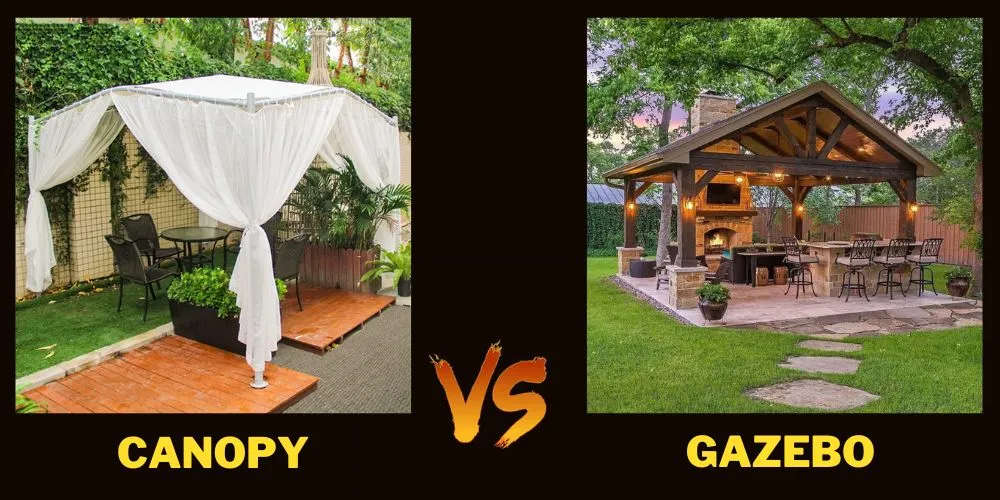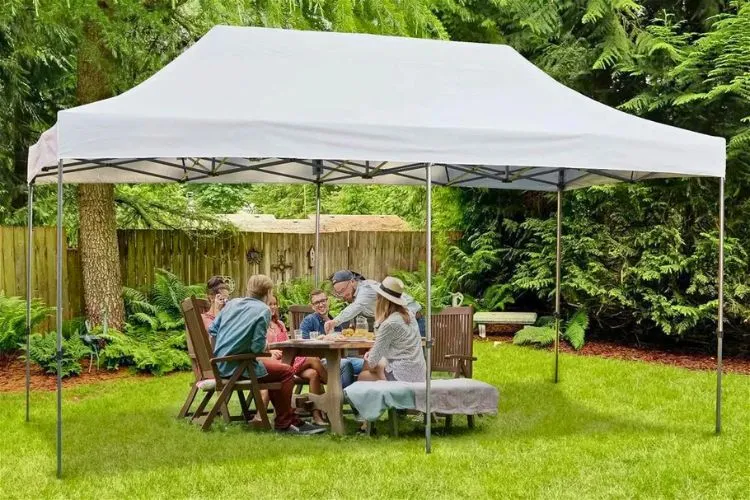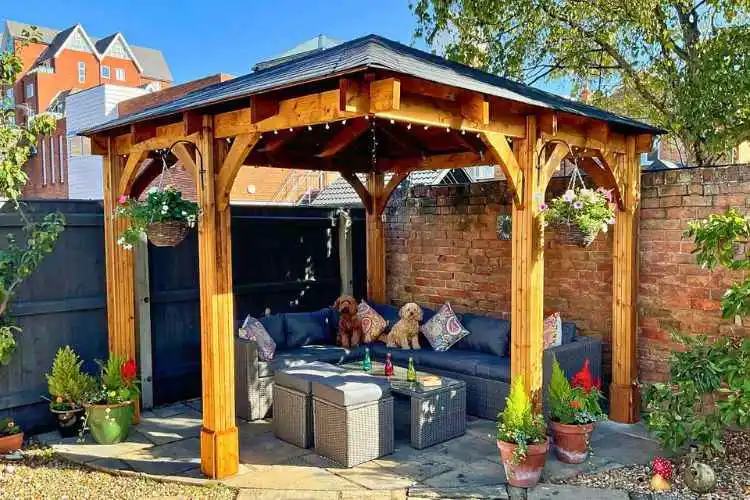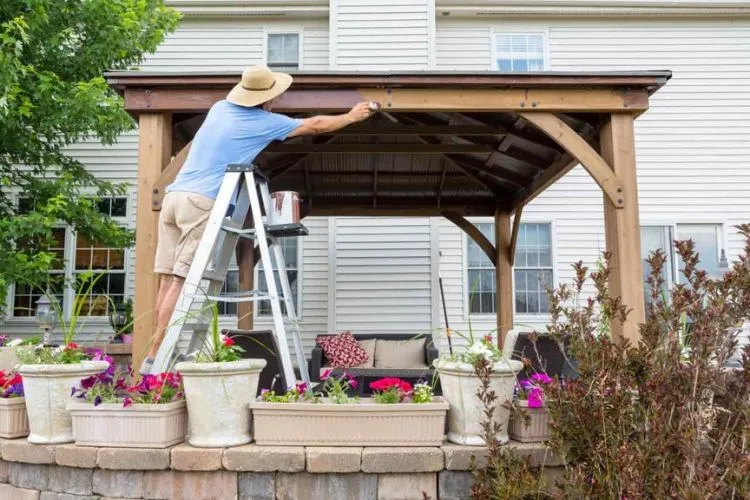When it comes to enhancing outdoor spaces, selecting the right type of shelter is crucial. Both canopies and gazebos serve as popular choices, but each has distinct features, benefits, and limitations.
Understanding these differences will help you make an informed decision based on your specific needs, budget, and preferences. This article explores the essentials of canopy vs gazebo, their pros and cons, and key considerations for choosing between them.

Contents
Understanding Canopies
A canopy is a versatile, flexible shelter often used for temporary outdoor events like markets, picnics, or beach outings.
Typically, canopies consist of a fabric cover stretched over a lightweight frame, usually made of aluminum or steel. The ease of setting up and taking down a canopy makes it highly practical for temporary use.

Pros of Canopies
One of the chief advantages of canopies is their portability. They are designed to be assembled quickly, often in just a few minutes, and with minimal effort.
This makes them perfect for those who need an immediate shelter solution without permanent installation.
Moreover, canopies are usually more affordable than gazebos, providing a cost-effective option for those who require a shelter on a budget. They also come in a range of sizes and styles, ensuring there is something to suit various needs and preferences.
Cons of Canopies
Despite their benefits, canopies do have some drawbacks. They are generally not as durable as gazebos and may not withstand harsh weather conditions like heavy rain or strong winds. This limits their functionality to favorable weather conditions and short-term use.
Understanding Gazebos
Gazebos are a more permanent outdoor structure, typically octagonal or rectangular in shape, and often constructed of wood, metal, or vinyl.
They provide shaded seating and enhance the aesthetic appeal of a garden or yard. Gazebos are built to be sturdy and durable, often forming a lasting part of the landscape.

Pros of Gazebos
The durability of gazebos stands out as their most significant advantage. They are designed to withstand the elements, providing a long-term solution for outdoor comfort and shelter. This permanence also means gazebos can contribute to property value enhancement.
From an aesthetic perspective, gazebos come in various designs and can be customized to fit particular styles and preferences, offering more than just functionality but also enhancing the visual appeal of outdoor spaces.
Cons of Gazebos
The major disadvantage of gazebos is their cost. They are typically more expensive than canopies, due to both the materials used and the need for professional installation.
Additionally, setting up a gazebo is far more time-consuming and may require more complex assembly or even construction work, which is a substantial consideration for those looking for a quick and easy shelter solution.
Canopy Vs Gazebo
Installation
The primary difference lies in their installation. Canopies offer temporary convenience, ideal for occasions that require quick setup and takedown.
Gazebos, however, are permanent fixtures that not only demand a greater initial investment but also a dedicated space in your landscape.
Material Quality and Durability
Material choice plays a critical role in the longevity of these shelters. Gazebos typically use robust materials like treated wood or metal, designed to endure various weather conditions.
Canopies, while practical, utilize lighter materials such as fabrics stretched over collapsible metal frames, prioritizing ease of transport and assembly over durability.
Functionality and Aesthetic Impact
While canopies serve well for temporary events, gazebos provide a permanent solution for year-round outdoor enjoyment.
The aesthetic impact of a beautifully designed gazebo can also significantly alter the character and usability of your outdoor space, turning it into a picturesque retreat.
You may also find useful: Gazebo vs Pergola | Marquee vs Gazebo
Choosing Between a Canopy and Gazebo
When deciding between a canopy and a gazebo, consider how you plan to use your outdoor shelter. Canopies are suitable for those who need a quick, flexible solution for events or occasional use.
Meanwhile, if you’re looking for a long-term, durable structure that enhances your outdoor living space, a gazebo is a better choice.
Additionally, consider your budget; canopies are less expensive and less demanding in terms of setup, while gazebos require a more significant investment in both money and time.
Maintenance and Care
Regular maintenance is key to prolonging the life of both canopies and gazebos.

Canopy Maintenance Guidelines
To maintain your canopy, clean the fabric regularly with mild soap and water, avoiding harsh chemicals that can degrade the material.
Check for tears or damage and address them promptly to prevent further issues. Store your canopy in a dry place when not in use to protect it from moisture and mold.
Gazebo Care Recommendations
Gazebos require occasional checks of their structural integrity, especially before and after harsh weather.
Wood gazebos may need staining or sealing every few years to prevent rot, while metal structures should be inspected for rust and treated accordingly.
Seasonal Considerations for Outdoor Shelters
Prepare your shelter for the changing seasons. In winter, remove any accumulated snow to avoid overloading the structure. During spring and autumn, clear debris such as leaves and twigs that could trap moisture or block drainage.
Protecting Your Shelter from Weather damage
Utilize weather-resistant covers and reinforcements to safeguard your shelter. Anchor canopies firmly to the ground, and consider using specialized treatments on gazebo materials to enhance their resistance to the elements.
These proactive measures help ensure your outdoor shelter remains a haven, come rain or shine.
Pro Tips
- Before purchasing, check your local weather trends to select a shelter that best corresponds to your area’s climate conditions.
- Always weigh the primary purpose against the practicality; if frequent moving or storage is required, a lightweight canopy would be the preferable option.
- For gazebos, potential buyers should also consider the need for ongoing maintenance to preserve the shelter’s condition and appearance.
Frequently Asked Questions (FAQs)
Can a canopy be used as a permanent outdoor structure?
Canopies are designed for temporary situations and are best suited for occasional use under favorable weather conditions.
How long does it take to assemble a gazebo?
Assembly time for a gazebo can range from a few hours to a weekend, depending on the complexity and size, and typically requires more than one person.
Do I need a permit to install a gazebo in my backyard?
Local regulations vary, so it’s essential to check with your city or county before installing a gazebo to determine if a permit is necessary.
Conclusion:
In conclusion, whether you choose a canopy or a gazebo depends on your specific needs, budget, and how you envision your outdoor space.
Knowing the key differences between the two will help ensure that you select the most appropriate outdoor shelter, making your outdoor time more enjoyable and stress-free.

Sergio Gomes, a passionate advocate for outdoor living and the male voice behind Shades Authority. With years of experience, Sergio is your trusted source for expert insights on gazebos, pavilions, cabanas, pergolas, and all things outdoor shade solutions. Join him on a journey to transform your outdoor spaces into stunning, functional retreats
